Management | All about Sexuality - Study
VerifiedAdded on 2022/08/21
|6
|2121
|15
AI Summary
Contribute Materials
Your contribution can guide someone’s learning journey. Share your
documents today.

Management
Secure Best Marks with AI Grader
Need help grading? Try our AI Grader for instant feedback on your assignments.
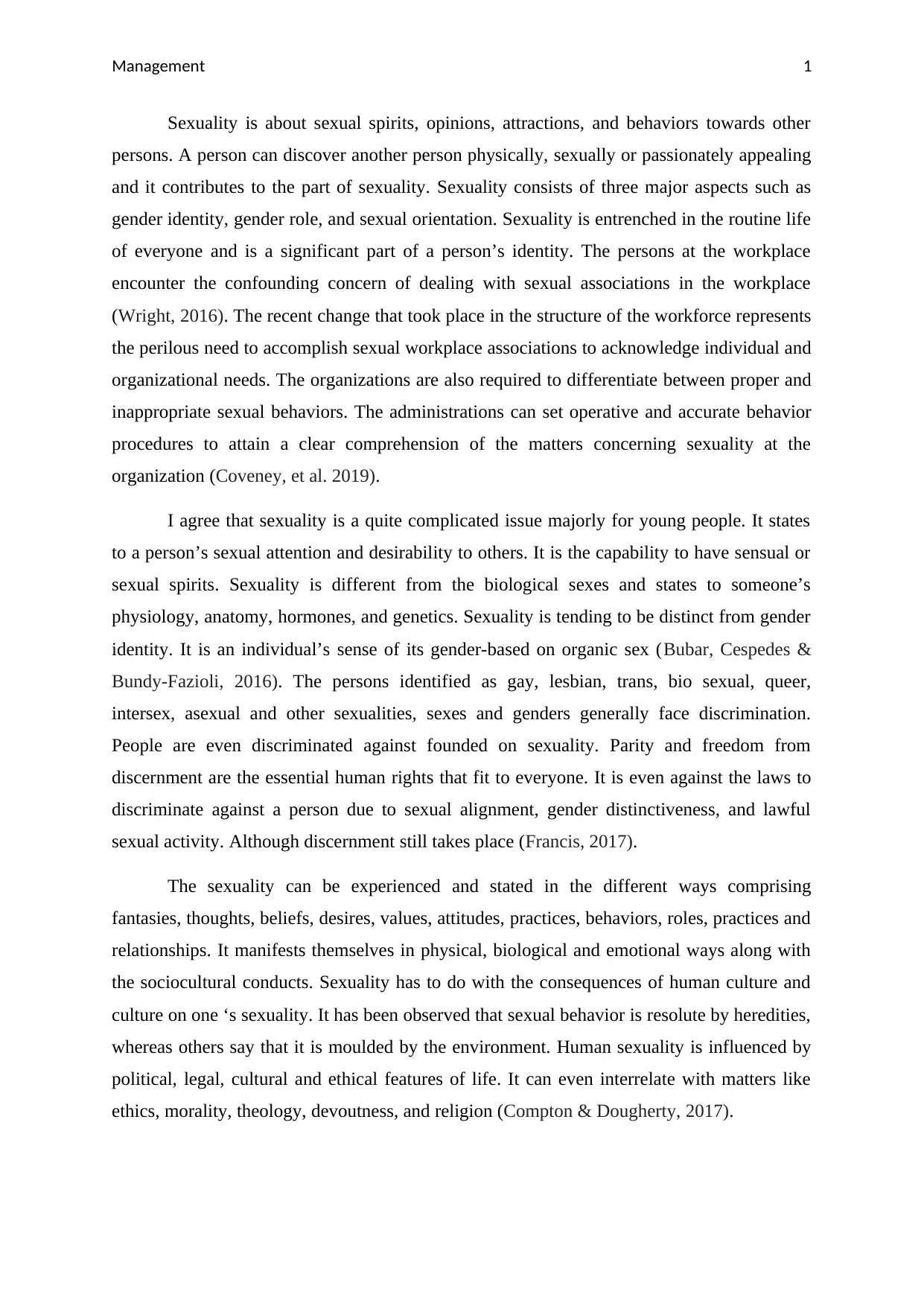
Management 1
Sexuality is about sexual spirits, opinions, attractions, and behaviors towards other
persons. A person can discover another person physically, sexually or passionately appealing
and it contributes to the part of sexuality. Sexuality consists of three major aspects such as
gender identity, gender role, and sexual orientation. Sexuality is entrenched in the routine life
of everyone and is a significant part of a person’s identity. The persons at the workplace
encounter the confounding concern of dealing with sexual associations in the workplace
(Wright, 2016). The recent change that took place in the structure of the workforce represents
the perilous need to accomplish sexual workplace associations to acknowledge individual and
organizational needs. The organizations are also required to differentiate between proper and
inappropriate sexual behaviors. The administrations can set operative and accurate behavior
procedures to attain a clear comprehension of the matters concerning sexuality at the
organization (Coveney, et al. 2019).
I agree that sexuality is a quite complicated issue majorly for young people. It states
to a person’s sexual attention and desirability to others. It is the capability to have sensual or
sexual spirits. Sexuality is different from the biological sexes and states to someone’s
physiology, anatomy, hormones, and genetics. Sexuality is tending to be distinct from gender
identity. It is an individual’s sense of its gender-based on organic sex (Bubar, Cespedes &
Bundy-Fazioli, 2016). The persons identified as gay, lesbian, trans, bio sexual, queer,
intersex, asexual and other sexualities, sexes and genders generally face discrimination.
People are even discriminated against founded on sexuality. Parity and freedom from
discernment are the essential human rights that fit to everyone. It is even against the laws to
discriminate against a person due to sexual alignment, gender distinctiveness, and lawful
sexual activity. Although discernment still takes place (Francis, 2017).
The sexuality can be experienced and stated in the different ways comprising
fantasies, thoughts, beliefs, desires, values, attitudes, practices, behaviors, roles, practices and
relationships. It manifests themselves in physical, biological and emotional ways along with
the sociocultural conducts. Sexuality has to do with the consequences of human culture and
culture on one ‘s sexuality. It has been observed that sexual behavior is resolute by heredities,
whereas others say that it is moulded by the environment. Human sexuality is influenced by
political, legal, cultural and ethical features of life. It can even interrelate with matters like
ethics, morality, theology, devoutness, and religion (Compton & Dougherty, 2017).
Sexuality is about sexual spirits, opinions, attractions, and behaviors towards other
persons. A person can discover another person physically, sexually or passionately appealing
and it contributes to the part of sexuality. Sexuality consists of three major aspects such as
gender identity, gender role, and sexual orientation. Sexuality is entrenched in the routine life
of everyone and is a significant part of a person’s identity. The persons at the workplace
encounter the confounding concern of dealing with sexual associations in the workplace
(Wright, 2016). The recent change that took place in the structure of the workforce represents
the perilous need to accomplish sexual workplace associations to acknowledge individual and
organizational needs. The organizations are also required to differentiate between proper and
inappropriate sexual behaviors. The administrations can set operative and accurate behavior
procedures to attain a clear comprehension of the matters concerning sexuality at the
organization (Coveney, et al. 2019).
I agree that sexuality is a quite complicated issue majorly for young people. It states
to a person’s sexual attention and desirability to others. It is the capability to have sensual or
sexual spirits. Sexuality is different from the biological sexes and states to someone’s
physiology, anatomy, hormones, and genetics. Sexuality is tending to be distinct from gender
identity. It is an individual’s sense of its gender-based on organic sex (Bubar, Cespedes &
Bundy-Fazioli, 2016). The persons identified as gay, lesbian, trans, bio sexual, queer,
intersex, asexual and other sexualities, sexes and genders generally face discrimination.
People are even discriminated against founded on sexuality. Parity and freedom from
discernment are the essential human rights that fit to everyone. It is even against the laws to
discriminate against a person due to sexual alignment, gender distinctiveness, and lawful
sexual activity. Although discernment still takes place (Francis, 2017).
The sexuality can be experienced and stated in the different ways comprising
fantasies, thoughts, beliefs, desires, values, attitudes, practices, behaviors, roles, practices and
relationships. It manifests themselves in physical, biological and emotional ways along with
the sociocultural conducts. Sexuality has to do with the consequences of human culture and
culture on one ‘s sexuality. It has been observed that sexual behavior is resolute by heredities,
whereas others say that it is moulded by the environment. Human sexuality is influenced by
political, legal, cultural and ethical features of life. It can even interrelate with matters like
ethics, morality, theology, devoutness, and religion (Compton & Dougherty, 2017).
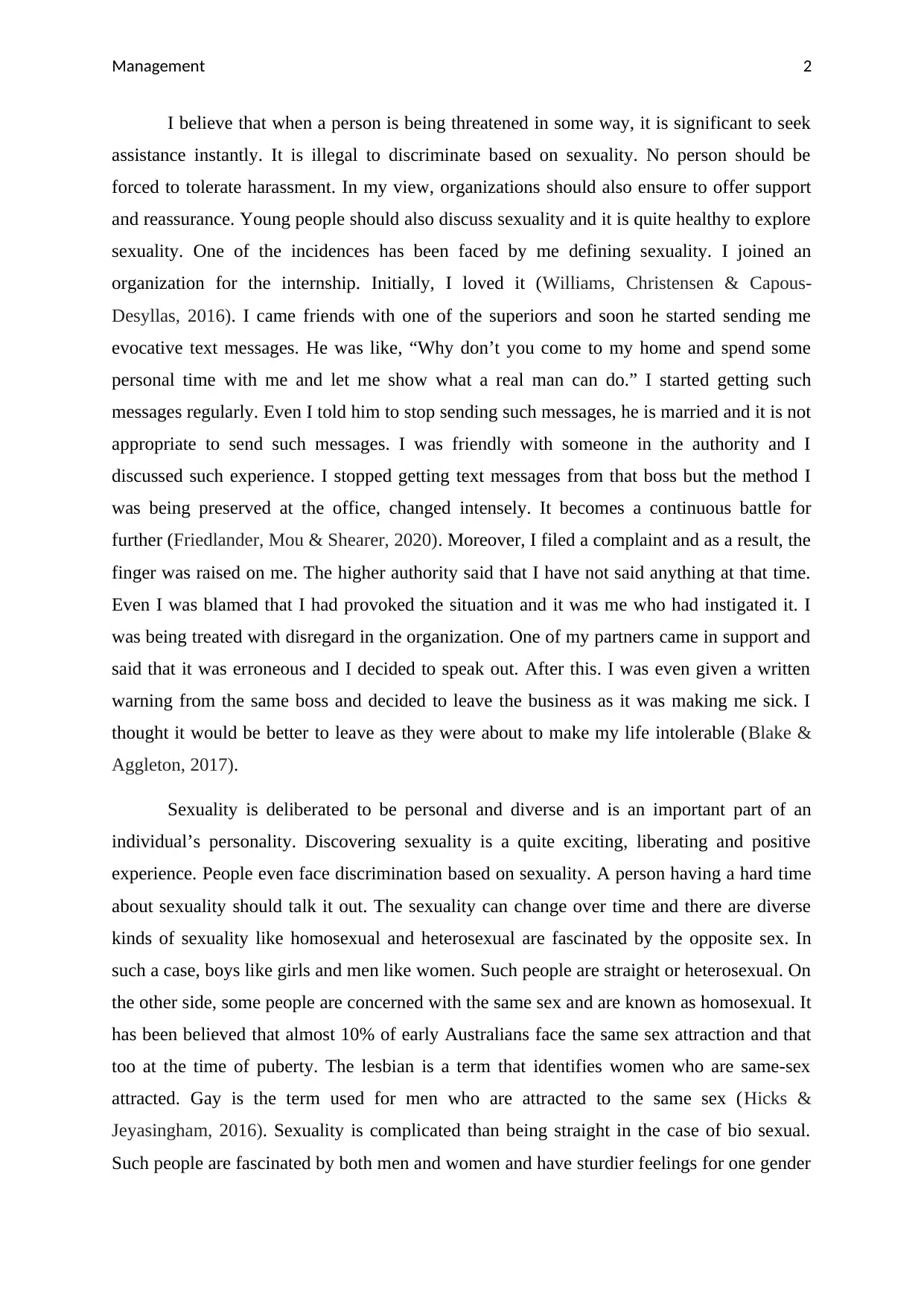
Management 2
I believe that when a person is being threatened in some way, it is significant to seek
assistance instantly. It is illegal to discriminate based on sexuality. No person should be
forced to tolerate harassment. In my view, organizations should also ensure to offer support
and reassurance. Young people should also discuss sexuality and it is quite healthy to explore
sexuality. One of the incidences has been faced by me defining sexuality. I joined an
organization for the internship. Initially, I loved it (Williams, Christensen & Capous-
Desyllas, 2016). I came friends with one of the superiors and soon he started sending me
evocative text messages. He was like, “Why don’t you come to my home and spend some
personal time with me and let me show what a real man can do.” I started getting such
messages regularly. Even I told him to stop sending such messages, he is married and it is not
appropriate to send such messages. I was friendly with someone in the authority and I
discussed such experience. I stopped getting text messages from that boss but the method I
was being preserved at the office, changed intensely. It becomes a continuous battle for
further (Friedlander, Mou & Shearer, 2020). Moreover, I filed a complaint and as a result, the
finger was raised on me. The higher authority said that I have not said anything at that time.
Even I was blamed that I had provoked the situation and it was me who had instigated it. I
was being treated with disregard in the organization. One of my partners came in support and
said that it was erroneous and I decided to speak out. After this. I was even given a written
warning from the same boss and decided to leave the business as it was making me sick. I
thought it would be better to leave as they were about to make my life intolerable (Blake &
Aggleton, 2017).
Sexuality is deliberated to be personal and diverse and is an important part of an
individual’s personality. Discovering sexuality is a quite exciting, liberating and positive
experience. People even face discrimination based on sexuality. A person having a hard time
about sexuality should talk it out. The sexuality can change over time and there are diverse
kinds of sexuality like homosexual and heterosexual are fascinated by the opposite sex. In
such a case, boys like girls and men like women. Such people are straight or heterosexual. On
the other side, some people are concerned with the same sex and are known as homosexual. It
has been believed that almost 10% of early Australians face the same sex attraction and that
too at the time of puberty. The lesbian is a term that identifies women who are same-sex
attracted. Gay is the term used for men who are attracted to the same sex (Hicks &
Jeyasingham, 2016). Sexuality is complicated than being straight in the case of bio sexual.
Such people are fascinated by both men and women and have sturdier feelings for one gender
I believe that when a person is being threatened in some way, it is significant to seek
assistance instantly. It is illegal to discriminate based on sexuality. No person should be
forced to tolerate harassment. In my view, organizations should also ensure to offer support
and reassurance. Young people should also discuss sexuality and it is quite healthy to explore
sexuality. One of the incidences has been faced by me defining sexuality. I joined an
organization for the internship. Initially, I loved it (Williams, Christensen & Capous-
Desyllas, 2016). I came friends with one of the superiors and soon he started sending me
evocative text messages. He was like, “Why don’t you come to my home and spend some
personal time with me and let me show what a real man can do.” I started getting such
messages regularly. Even I told him to stop sending such messages, he is married and it is not
appropriate to send such messages. I was friendly with someone in the authority and I
discussed such experience. I stopped getting text messages from that boss but the method I
was being preserved at the office, changed intensely. It becomes a continuous battle for
further (Friedlander, Mou & Shearer, 2020). Moreover, I filed a complaint and as a result, the
finger was raised on me. The higher authority said that I have not said anything at that time.
Even I was blamed that I had provoked the situation and it was me who had instigated it. I
was being treated with disregard in the organization. One of my partners came in support and
said that it was erroneous and I decided to speak out. After this. I was even given a written
warning from the same boss and decided to leave the business as it was making me sick. I
thought it would be better to leave as they were about to make my life intolerable (Blake &
Aggleton, 2017).
Sexuality is deliberated to be personal and diverse and is an important part of an
individual’s personality. Discovering sexuality is a quite exciting, liberating and positive
experience. People even face discrimination based on sexuality. A person having a hard time
about sexuality should talk it out. The sexuality can change over time and there are diverse
kinds of sexuality like homosexual and heterosexual are fascinated by the opposite sex. In
such a case, boys like girls and men like women. Such people are straight or heterosexual. On
the other side, some people are concerned with the same sex and are known as homosexual. It
has been believed that almost 10% of early Australians face the same sex attraction and that
too at the time of puberty. The lesbian is a term that identifies women who are same-sex
attracted. Gay is the term used for men who are attracted to the same sex (Hicks &
Jeyasingham, 2016). Sexuality is complicated than being straight in the case of bio sexual.
Such people are fascinated by both men and women and have sturdier feelings for one gender
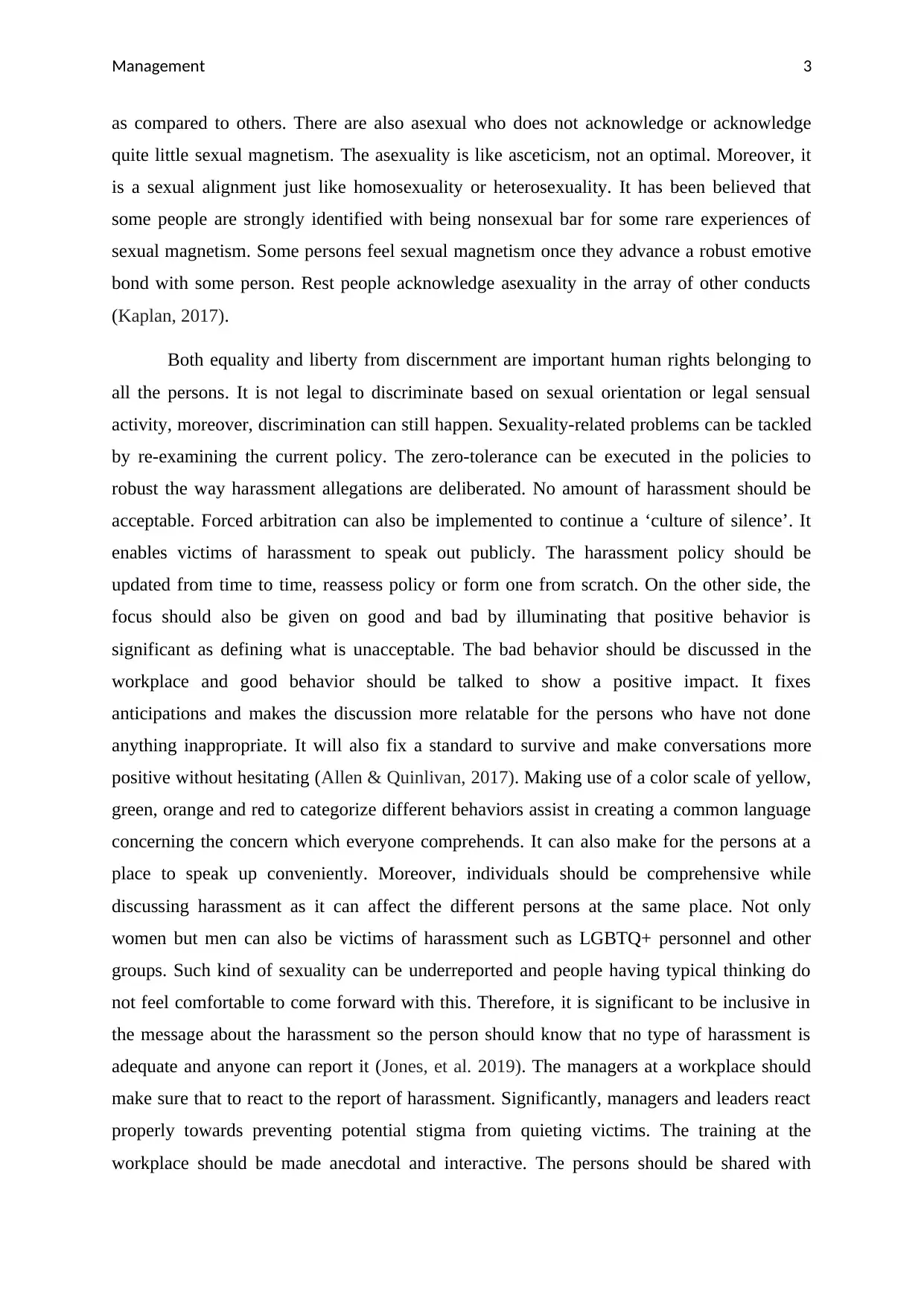
Management 3
as compared to others. There are also asexual who does not acknowledge or acknowledge
quite little sexual magnetism. The asexuality is like asceticism, not an optimal. Moreover, it
is a sexual alignment just like homosexuality or heterosexuality. It has been believed that
some people are strongly identified with being nonsexual bar for some rare experiences of
sexual magnetism. Some persons feel sexual magnetism once they advance a robust emotive
bond with some person. Rest people acknowledge asexuality in the array of other conducts
(Kaplan, 2017).
Both equality and liberty from discernment are important human rights belonging to
all the persons. It is not legal to discriminate based on sexual orientation or legal sensual
activity, moreover, discrimination can still happen. Sexuality-related problems can be tackled
by re-examining the current policy. The zero-tolerance can be executed in the policies to
robust the way harassment allegations are deliberated. No amount of harassment should be
acceptable. Forced arbitration can also be implemented to continue a ‘culture of silence’. It
enables victims of harassment to speak out publicly. The harassment policy should be
updated from time to time, reassess policy or form one from scratch. On the other side, the
focus should also be given on good and bad by illuminating that positive behavior is
significant as defining what is unacceptable. The bad behavior should be discussed in the
workplace and good behavior should be talked to show a positive impact. It fixes
anticipations and makes the discussion more relatable for the persons who have not done
anything inappropriate. It will also fix a standard to survive and make conversations more
positive without hesitating (Allen & Quinlivan, 2017). Making use of a color scale of yellow,
green, orange and red to categorize different behaviors assist in creating a common language
concerning the concern which everyone comprehends. It can also make for the persons at a
place to speak up conveniently. Moreover, individuals should be comprehensive while
discussing harassment as it can affect the different persons at the same place. Not only
women but men can also be victims of harassment such as LGBTQ+ personnel and other
groups. Such kind of sexuality can be underreported and people having typical thinking do
not feel comfortable to come forward with this. Therefore, it is significant to be inclusive in
the message about the harassment so the person should know that no type of harassment is
adequate and anyone can report it (Jones, et al. 2019). The managers at a workplace should
make sure that to react to the report of harassment. Significantly, managers and leaders react
properly towards preventing potential stigma from quieting victims. The training at the
workplace should be made anecdotal and interactive. The persons should be shared with
as compared to others. There are also asexual who does not acknowledge or acknowledge
quite little sexual magnetism. The asexuality is like asceticism, not an optimal. Moreover, it
is a sexual alignment just like homosexuality or heterosexuality. It has been believed that
some people are strongly identified with being nonsexual bar for some rare experiences of
sexual magnetism. Some persons feel sexual magnetism once they advance a robust emotive
bond with some person. Rest people acknowledge asexuality in the array of other conducts
(Kaplan, 2017).
Both equality and liberty from discernment are important human rights belonging to
all the persons. It is not legal to discriminate based on sexual orientation or legal sensual
activity, moreover, discrimination can still happen. Sexuality-related problems can be tackled
by re-examining the current policy. The zero-tolerance can be executed in the policies to
robust the way harassment allegations are deliberated. No amount of harassment should be
acceptable. Forced arbitration can also be implemented to continue a ‘culture of silence’. It
enables victims of harassment to speak out publicly. The harassment policy should be
updated from time to time, reassess policy or form one from scratch. On the other side, the
focus should also be given on good and bad by illuminating that positive behavior is
significant as defining what is unacceptable. The bad behavior should be discussed in the
workplace and good behavior should be talked to show a positive impact. It fixes
anticipations and makes the discussion more relatable for the persons who have not done
anything inappropriate. It will also fix a standard to survive and make conversations more
positive without hesitating (Allen & Quinlivan, 2017). Making use of a color scale of yellow,
green, orange and red to categorize different behaviors assist in creating a common language
concerning the concern which everyone comprehends. It can also make for the persons at a
place to speak up conveniently. Moreover, individuals should be comprehensive while
discussing harassment as it can affect the different persons at the same place. Not only
women but men can also be victims of harassment such as LGBTQ+ personnel and other
groups. Such kind of sexuality can be underreported and people having typical thinking do
not feel comfortable to come forward with this. Therefore, it is significant to be inclusive in
the message about the harassment so the person should know that no type of harassment is
adequate and anyone can report it (Jones, et al. 2019). The managers at a workplace should
make sure that to react to the report of harassment. Significantly, managers and leaders react
properly towards preventing potential stigma from quieting victims. The training at the
workplace should be made anecdotal and interactive. The persons should be shared with
Secure Best Marks with AI Grader
Need help grading? Try our AI Grader for instant feedback on your assignments.
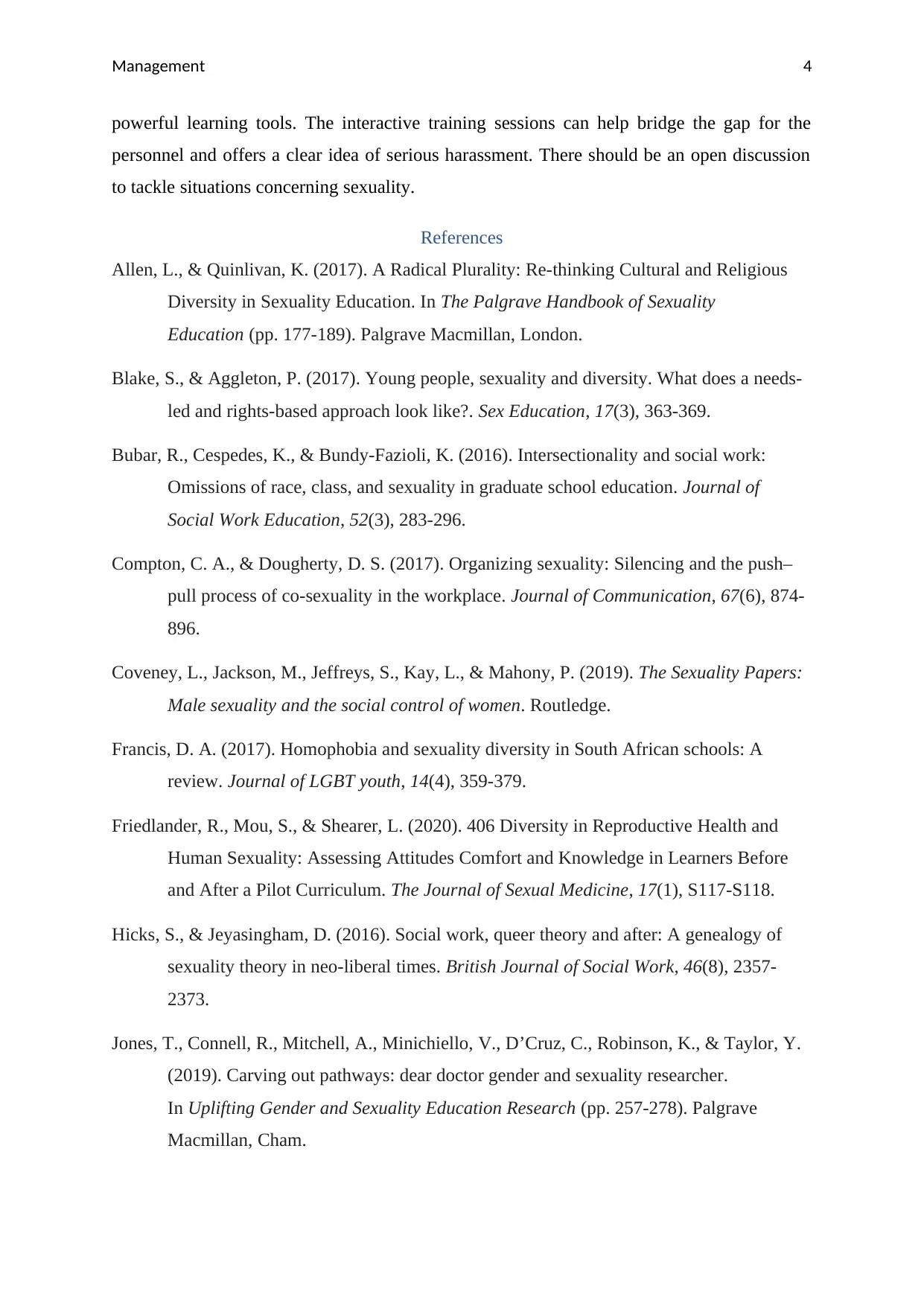
Management 4
powerful learning tools. The interactive training sessions can help bridge the gap for the
personnel and offers a clear idea of serious harassment. There should be an open discussion
to tackle situations concerning sexuality.
References
Allen, L., & Quinlivan, K. (2017). A Radical Plurality: Re-thinking Cultural and Religious
Diversity in Sexuality Education. In The Palgrave Handbook of Sexuality
Education (pp. 177-189). Palgrave Macmillan, London.
Blake, S., & Aggleton, P. (2017). Young people, sexuality and diversity. What does a needs-
led and rights-based approach look like?. Sex Education, 17(3), 363-369.
Bubar, R., Cespedes, K., & Bundy-Fazioli, K. (2016). Intersectionality and social work:
Omissions of race, class, and sexuality in graduate school education. Journal of
Social Work Education, 52(3), 283-296.
Compton, C. A., & Dougherty, D. S. (2017). Organizing sexuality: Silencing and the push–
pull process of co-sexuality in the workplace. Journal of Communication, 67(6), 874-
896.
Coveney, L., Jackson, M., Jeffreys, S., Kay, L., & Mahony, P. (2019). The Sexuality Papers:
Male sexuality and the social control of women. Routledge.
Francis, D. A. (2017). Homophobia and sexuality diversity in South African schools: A
review. Journal of LGBT youth, 14(4), 359-379.
Friedlander, R., Mou, S., & Shearer, L. (2020). 406 Diversity in Reproductive Health and
Human Sexuality: Assessing Attitudes Comfort and Knowledge in Learners Before
and After a Pilot Curriculum. The Journal of Sexual Medicine, 17(1), S117-S118.
Hicks, S., & Jeyasingham, D. (2016). Social work, queer theory and after: A genealogy of
sexuality theory in neo-liberal times. British Journal of Social Work, 46(8), 2357-
2373.
Jones, T., Connell, R., Mitchell, A., Minichiello, V., D’Cruz, C., Robinson, K., & Taylor, Y.
(2019). Carving out pathways: dear doctor gender and sexuality researcher.
In Uplifting Gender and Sexuality Education Research (pp. 257-278). Palgrave
Macmillan, Cham.
powerful learning tools. The interactive training sessions can help bridge the gap for the
personnel and offers a clear idea of serious harassment. There should be an open discussion
to tackle situations concerning sexuality.
References
Allen, L., & Quinlivan, K. (2017). A Radical Plurality: Re-thinking Cultural and Religious
Diversity in Sexuality Education. In The Palgrave Handbook of Sexuality
Education (pp. 177-189). Palgrave Macmillan, London.
Blake, S., & Aggleton, P. (2017). Young people, sexuality and diversity. What does a needs-
led and rights-based approach look like?. Sex Education, 17(3), 363-369.
Bubar, R., Cespedes, K., & Bundy-Fazioli, K. (2016). Intersectionality and social work:
Omissions of race, class, and sexuality in graduate school education. Journal of
Social Work Education, 52(3), 283-296.
Compton, C. A., & Dougherty, D. S. (2017). Organizing sexuality: Silencing and the push–
pull process of co-sexuality in the workplace. Journal of Communication, 67(6), 874-
896.
Coveney, L., Jackson, M., Jeffreys, S., Kay, L., & Mahony, P. (2019). The Sexuality Papers:
Male sexuality and the social control of women. Routledge.
Francis, D. A. (2017). Homophobia and sexuality diversity in South African schools: A
review. Journal of LGBT youth, 14(4), 359-379.
Friedlander, R., Mou, S., & Shearer, L. (2020). 406 Diversity in Reproductive Health and
Human Sexuality: Assessing Attitudes Comfort and Knowledge in Learners Before
and After a Pilot Curriculum. The Journal of Sexual Medicine, 17(1), S117-S118.
Hicks, S., & Jeyasingham, D. (2016). Social work, queer theory and after: A genealogy of
sexuality theory in neo-liberal times. British Journal of Social Work, 46(8), 2357-
2373.
Jones, T., Connell, R., Mitchell, A., Minichiello, V., D’Cruz, C., Robinson, K., & Taylor, Y.
(2019). Carving out pathways: dear doctor gender and sexuality researcher.
In Uplifting Gender and Sexuality Education Research (pp. 257-278). Palgrave
Macmillan, Cham.
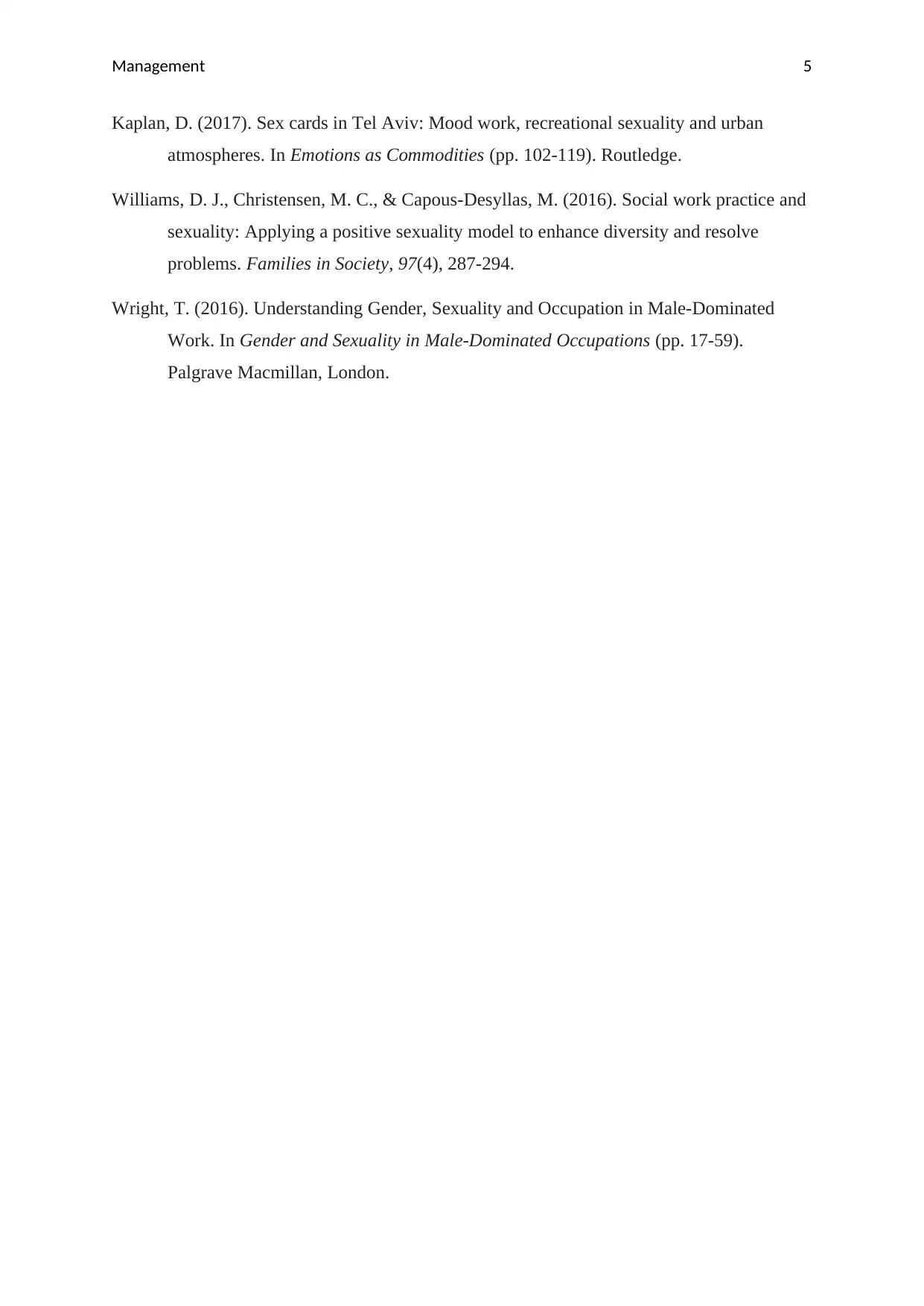
Management 5
Kaplan, D. (2017). Sex cards in Tel Aviv: Mood work, recreational sexuality and urban
atmospheres. In Emotions as Commodities (pp. 102-119). Routledge.
Williams, D. J., Christensen, M. C., & Capous-Desyllas, M. (2016). Social work practice and
sexuality: Applying a positive sexuality model to enhance diversity and resolve
problems. Families in Society, 97(4), 287-294.
Wright, T. (2016). Understanding Gender, Sexuality and Occupation in Male-Dominated
Work. In Gender and Sexuality in Male-Dominated Occupations (pp. 17-59).
Palgrave Macmillan, London.
Kaplan, D. (2017). Sex cards in Tel Aviv: Mood work, recreational sexuality and urban
atmospheres. In Emotions as Commodities (pp. 102-119). Routledge.
Williams, D. J., Christensen, M. C., & Capous-Desyllas, M. (2016). Social work practice and
sexuality: Applying a positive sexuality model to enhance diversity and resolve
problems. Families in Society, 97(4), 287-294.
Wright, T. (2016). Understanding Gender, Sexuality and Occupation in Male-Dominated
Work. In Gender and Sexuality in Male-Dominated Occupations (pp. 17-59).
Palgrave Macmillan, London.
1 out of 6
Related Documents
Your All-in-One AI-Powered Toolkit for Academic Success.
+13062052269
info@desklib.com
Available 24*7 on WhatsApp / Email
![[object Object]](/_next/static/media/star-bottom.7253800d.svg)
Unlock your academic potential
© 2024 | Zucol Services PVT LTD | All rights reserved.





